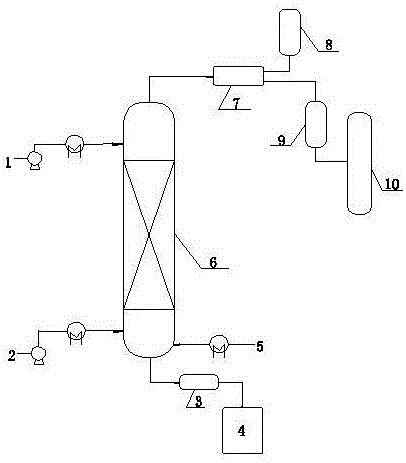Method for removing water in continuous esterifying process
A technology for removing water and esterification, applied in chemical instruments and methods, preparation of organic compounds, formation/introduction of carboxylate groups, etc., can solve the problems of increasing excess component circulation and increasing energy consumption
- Summary
- Abstract
- Description
- Claims
- Application Information
AI Technical Summary
Problems solved by technology
Method used
Image
Examples
Embodiment 1
[0033] Preparation of ethyl laurate
[0034] Add D008 strongly acidic ion resin catalyst into the fixed bed reactor 6. Make lauric acid into 1 mol / L ethanol solution, add it from the upper part of the fixed bed reactor 6 at a rate of 1.0 mL / min, and add ethanol from the lower part of the fixed bed reactor at a rate of 0.5 mL / min. The carrier gas was nitrogen at a flow rate of 100 mL / min. The ethanol solution of lauric acid and the preheater temperature of ethanol are both 100°C, the temperature of the nitrogen preheater is 150°C, and the temperature of the fixed bed reactor is 100°C. The final yield of ethyl laurate is ≥99.2%.
Embodiment 2
[0036] Diethyl terephthalate
[0037] Add SO to the fixed bed reactor 4 2- / TiO 2Solid superacid catalyst. Terephthalic acid was made into a 1 mol / L ethanol solution, which was added at a rate of 1.0 mL / min from the upper part of the fixed-bed reactor, and ethanol was added at a rate of 1.0 mL / min from the lower part of the fixed-bed reactor. The carrier gas was argon with a flow rate of 15 mL / min. The temperature of the ethanol solution of terephthalic acid, ethanol and argon is all 120°C. The temperature of the fixed bed reactor was 120°C. The final conversion rate of terephthalic acid is ≥99.0%, and the selectivity of diethyl terephthalate is ≥98.5%.
Embodiment 3
[0039] Poly(hexanediol adipate)
[0040] Add H into the fixed bed reactor 3 PW 12 o 40 ·nH20 heteropolyacid catalyst. Mix adipic acid and hexanediol in equimolar amounts to prepare a dioxane solution with a single component concentration of 0.5 mol / L, and add it from the upper part of the fixed-bed reactor at a rate of 1.0 mL / min. The carrier gas was argon with a flow rate of 15 mL / min. The preheater temperature of the mixed solution was 150°C, and the preheating temperature of the argon gas was 200°C. The temperature of the fixed bed reactor was 150°C. The final reaction produces poly(hexanediol adipate) with a number average molecular weight of 2123.5.
PUM
 Login to View More
Login to View More Abstract
Description
Claims
Application Information
 Login to View More
Login to View More - R&D
- Intellectual Property
- Life Sciences
- Materials
- Tech Scout
- Unparalleled Data Quality
- Higher Quality Content
- 60% Fewer Hallucinations
Browse by: Latest US Patents, China's latest patents, Technical Efficacy Thesaurus, Application Domain, Technology Topic, Popular Technical Reports.
© 2025 PatSnap. All rights reserved.Legal|Privacy policy|Modern Slavery Act Transparency Statement|Sitemap|About US| Contact US: help@patsnap.com

